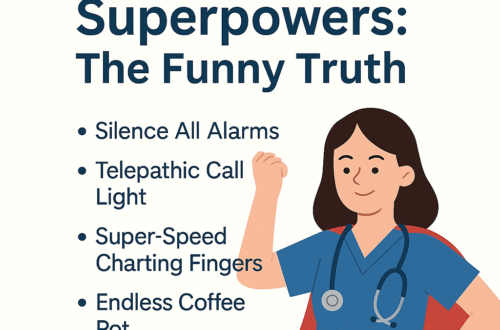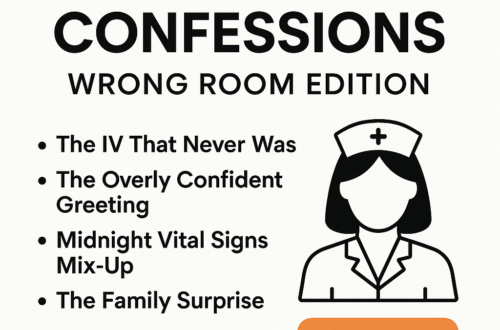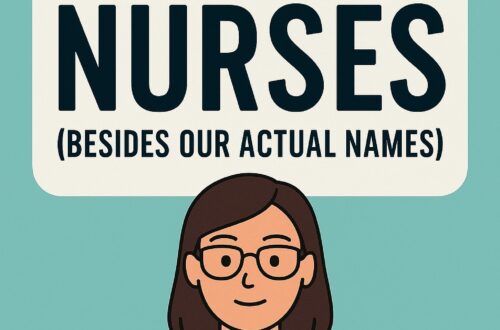Every nurse has heard the phrase: “At least you only work three days a week!”
Cue the collective eye roll. Because the real math of nursing shifts doesn’t add up to a neat three-day schedule. In fact, nursing math is its own strange subject, one not found in any NCLEX prep book.
On paper, a 12-hour shift should be just that—12 hours.
In reality? It’s a complicated equation filled with charting, alarms, call lights, codes, and the universal truth that a patient will always spike a fever exactly five minutes before shift change.
This post unpacks the true arithmetic of a nurse’s workday—equal parts reality check and humor. Because if we don’t laugh about it, we might just cry into our stethoscopes.
The Myth vs. The Reality of the “12-Hour Shift”
- The Myth: Nurses clock in at 7 a.m., clock out at 7 p.m., and go home. Easy math.
- The Reality: Nurses clock in before 7 a.m., stay at least an hour past 7 p.m., and still spend time at home thinking about that patient in room 12.
The Standard Nursing Math Equation
12 hours of work + 2 hours of charting + 1 hour of helping coworkers + 30 minutes of emotional processing = 15.5 hours, minimum.
That doesn’t account for the time spent commuting, unwinding, or explaining to your family why you’re too tired to explain anything.
Nurses always joke that 12-hour shifts feel more like 14 hours—and research backs it up. The “CDC reports that healthcare workers who work long shifts face higher risks of fatigue, stress, and burnout.”
👉 CDC – Risk Factors for Stress & Burnout
Nurse Shift Time Conversions (Because Time Works Differently Here)
Nursing shifts follow their own time zone. Let’s break down how minutes actually translate:
- 30-Minute Lunch Break
Real math: 7 minutes of actual eating, 23 minutes running to check IV pumps, answering phone calls, or being pulled into a room. - 1-Minute Bathroom Break
Real math: At least 15 patient call lights, one code brown down the hall, and a physician suddenly needing you for “just a quick update.” - 5 Minutes Before Shift Change
Real math: A patient decides to pull out their IV, another spikes a fever, and your replacement is suddenly “running a little late.” - 12-Hour Shift
Real math: Relative infinity. You lose track of the hours, and time bends like a black hole.
Nursing Word Problems (Because Nursing Life Is Basically Math Class)
- Word Problem #1: Charting Black Hole
If Nurse A has 5 patients and spends an average of 15 minutes charting per patient per hour, how much charting is left by the end of the shift?
Answer: All of it. There is always charting left. - Word Problem #2: Alarm Symphony
If each of Nurse B’s 4 patients has 2 IV pumps and 1 monitor, and each device alarms every 12 minutes, how many alarms does the nurse hear per shift?
Answer: Infinity. The alarms don’t stop when you go home either—you’ll hear phantom beeping in your dreams. - Word Problem #3: Call Light Marathon
If a nurse has 6 patients, and each patient hits the call light an average of 5 times per hour, how many steps will the nurse take over 12 hours?
Answer: Somewhere between 12,000 and 20,000—basically a marathon without the medal.
Why Nursing Math Defies Physics
Let’s get scientific for a moment. Nursing doesn’t just stretch hours; it bends reality.
- Shift Swallowing Black Hole: The mysterious void between 3 p.m. and 7 p.m. where time ceases to exist.
- Charting Time Warp: The longer you spend catching up, the more charting multiplies.
- Shift Creep Phenomenon: “Just one more thing” turns into 12 more things, extending your shift by 47 minutes.
Even Einstein would have admitted defeat trying to explain the relativity of a nurse’s workday.
The Emotional Math of Nursing Shifts
Nursing math isn’t just about time—it’s about energy.
- Compassion Units: Every tear wiped, every hand held, every worried family comforted takes its toll.
- Decision Fatigue: By the tenth hour, you’ve made 3,000 tiny decisions, from medication checks to “should I risk sitting down for 30 seconds?”
- Stress Multiplication: One patient going bad equals stress levels for all five patients skyrocketing.
The Financial Math of Nursing (Spoiler: It’s Complicated)
Let’s not forget paychecks. Nursing math and paycheck math are cousins.
- Overtime is nice—until you realize your “extra hours” came at the cost of your knees, your back, and your will to meal prep.
- Three 12-hour shifts per week sounds dreamy—until you realize those days are 15-hour marathons and you’re in recovery mode on your “days off.”
- Nurses often calculate pay in “how many Starbucks lattes this will cover” or “is this enough to justify new compression socks?”
Pro Tips for Surviving the Numbers Game
Nursing math will never add up neatly—but you can hack it.
1. Stop Counting the Hours
Staring at the clock makes it worse. Think in chunks: “Make it to lunch,” “Make it to shift change.”
2. Build in Buffer Time
Just accept that “12 hours” is actually 14. Plan accordingly.
3. Snacks = Extra Survival Points
Granola bars, almonds, or the holy grail—unit-provided donuts—can extend endurance by at least 30 minutes.
4. Buddy Math
Helping each other makes the math less brutal. Cover your coworker’s bathroom break, and they’ll return the favor.
5. Don’t Take It Home
Charting, yes. Emotional math, no. Leave that at the unit door when possible.
The Humor in Nurse Math (Because Laughter is Survival)
If you don’t laugh about the math of nursing, you’ll cry. That’s why nurse humor is a coping mechanism.
- “I’ve been here so long, do I get squatters’ rights?”
- “If I sit for 5 minutes, the universe owes me 10 more call lights.”
- “My Fitbit thinks I’m in an Olympic training program.”
Relatable humor connects nurses across shifts, hospitals, and specialties. It reminds us we’re not alone in the madness.
Why Every Nurse Needs to Share This Math
This isn’t just venting—it’s education. Families, administrators, and the public need to understand that a nurse’s 12-hour shift is more like a 15-hour marathon.
Conclusion: The Only Constant Is That 12 ≠ 12
In nursing, 12 doesn’t mean 12. It means 14, 15, sometimes 16. It means a day that swallows hours whole, drains your emotional calculator, and still leaves you laughing at the absurdity.
The real math of nursing shifts isn’t about precision—it’s about resilience, humor, and knowing that no matter how bad today’s equation looks, there’s another team coming in to solve it tomorrow.
So the next time someone says, “At least you only work three days a week,” just smile. Because they’ll never understand the math—and that’s probably for the best.




